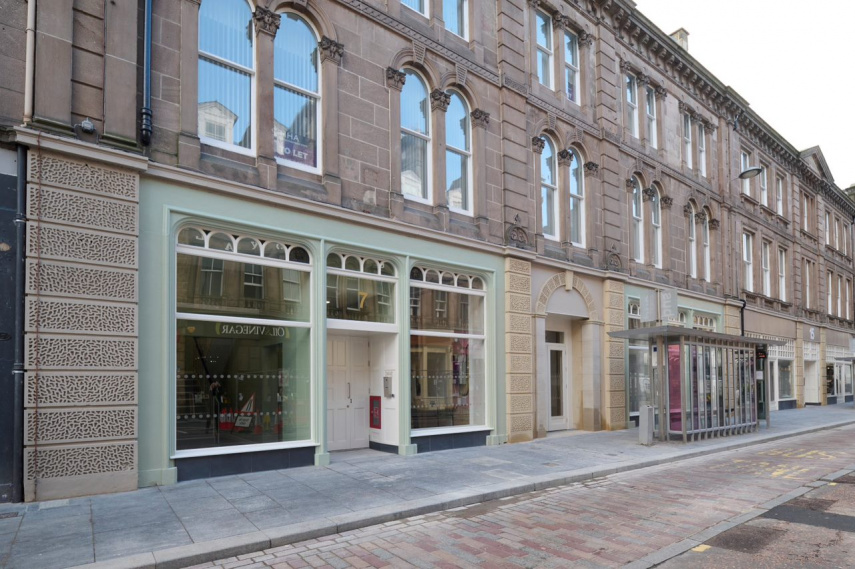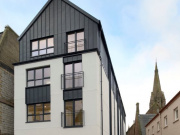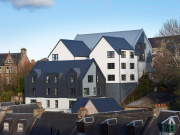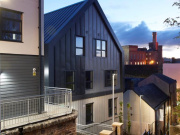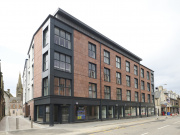Highland Council – Inverness City Living
The Highland Council has devised an ambitious strategy for Inverness city centre. Faced with the decline of the traditional high street and concerned about the negative consequences for the city centre environment, the council developed ambitious plans to revitalise the centre. This involved the development of an Inverness Strategy, including a City Centre Masterplan. The strategy aims to make the city centre an area where people live and work, somewhere with green space and active travel routes.
Housing is at the heart of the strategy, viewed as “a fundamental component of a successful, vibrant and mixed-use place, supporting a 24-hour economy and providing natural surveillance of our city streets.”
Even before the strategy was published, the Highland Council had been investing in city centre housing, working closely with its partner the Highland Housing Alliance (HHA), a not-for-profit development company.
This case study looks at the objectives behind the drive to develop city centre housing while examining some of the challenges to making city centre living a choice for more households. It also looks at the factors behind the council and HHA’s success.
Inverness City Living – Aims and Objectives
Highland Council have two clear objectives underpinning their push for city centre housing. The first is regeneration – they are clearly aware of the change in the retail market and the threat that this poses to the city centre and its built heritage. There is a need to move from shopping to other uses.
The second major objective is meeting housing need. Inverness is growing quickly (the Scottish Cities Alliance state that Inverness is Scotland’s fastest growing city, with a 15% jump in population since 2001). Housing is in high demand, with council homes put up for let receiving multiple bids.
The council has published a vision for Inverness city centre. The aim is to create an attractive place where people can comfortably live and work and that others will visit to access a range of services and facilities and to spend their leisure time.
In developing city centre housing, the council has clearly targeted young people. Apart from the redevelopment of the former Inverness Royal Academy site (accessible housing for people aged 55 and over) city centre housing developments have been aimed at young people, particularly younger people moving to Inverness to work. Developing city living is seen as a way to regenerate the city centre, meet housing need and attract young people and key workers to the area.
Challenges and Barriers
Highland Council face clear challenges in delivering city centre living at scale. The main challenge is that the large housebuilders who deliver most of Scotland’s new homes are not interested in building homes in and around the city centre. The large housebuilders’ business model works better building larger homes on greenfield sites, thereby reducing development risk and increasing profit.
The second challenge around delivering city centre living in Inverness is market demand. While, as noted above, there is strong demand for affordable housing, Highland Council’s view was that market demand in Inverness for housing for sale is for housing with car parking spaces, and that this is even the case among first time buyers. There is perhaps a need for market research here as well as for market making by making the city centre greener and more attractive (as the City Centre Masterplan proposes) and delivering a range of tenures at scale.
To date, the bulk of new housing built in the city centre has been either for social rent or mid-market rent and owned and managed by HHA. Highland Council are clear that they need to deliver mixed tenure housing and create a market for housing for sale and market rent in the city centre.
The council plans to target new housing for rent and sale on young workers moving to the city. This strategy seeks to deliver the twin objectives of regenerating the city centre plus attracting and retaining young workers to make Inverness competitive.
Costs are a barrier to delivering city centre housing – for each of the city centre projects a cocktail of funding has been required to meet the higher costs of developing in the city centre – for example City Region Deal money has provided top up funding on each project.
Increasing fire safety and energy efficiency standards were also raised as a barrier – while neither the council nor HHA objected to raising standards they were clear that it is more challenging to achieve these standards in existing buildings.
The complexity of multiple ownership in city centre sites was also cited as a barrier to delivery. While the council and HHA have a strong track record in managing risk and delivering city living, reform of Compulsory Purchase Order legislation was seen as having potential to enable the assembly development of sites. A particular concern was the issue of hope value for sites with the aspirations of site and building owners being viewed as unrealistic.
A Long-Term Strategy: The Inverness Strategy and the City Centre Masterplan
The Inverness Strategy is supported by a City Centre Masterplan. Objectives of the Masterplan include:
- Creating welcoming mixed-use neighbourhoods that provide quality homes for young people, families and older people
- An attractive, healthy built and natural environment where people can meet, dwell and socialise in safe accessible public spaces
- Regeneration and new development in the city centre facilitates a just transition to a low carbon, green and circular economy
- It provides a safe place that is easy to walk and wheel around, where public transport is accessible, and vehicles do not dominate available space.
Projects to date
To date the council and their partners HHA have delivered a significant number of projects:
- Raining’s Close (16 units)
- Inverness Royal Academy (30 units)
- 92 – 94 Academy Street (31 units)
- Wyvern House (37 units)
- Former Arnotts Building (53 units – under development)
- Castle Street (8 units – under development)
- Glashan Court, Church Street (10 Units).
Looking Forward
Highland Council have a clear focus on delivering city living, with the City Centre Masterplan and the Inverness City Vision demonstrating a long term commitment and plan to increase activity and the number of people living in the city centre.
Highland Council and the Highland Housing Alliance have had considerable success in delivering city living and with early action underway to deliver on the City Vision, city living will become more attractive.
Having delivered midmarket rent in partnership with HHA, the council is keen to provide a wider range of tenures and is developing two new projects for low cost sale.
Why it works and what we can learn
The success of city living projects in the Highland capital are in large part due to the skills and appetite for managed risk that both Highland Council and HHA have demonstrated. Other contributing factors have been the use of City Region Deal Funding, the establishment of a Land Bank fund and the creation of a company which acts as a developer but aims to deliver public good (HHA).
Even with these strengths and with the vision and confidence demonstrated by the City Vision, delivering city living is a major challenge. Even in a booming market like Inverness, there is market failure as private developers no longer build out town centre infill sites. To deliver the vision for Inverness there needs to be more support for city living, or a model that enables housing for sale to be developed at scale within the city centre.
